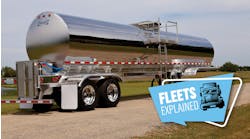The growing shortage of technicians serving the trucking industry is not a problem that's going from bad to worse — it's a problem that's going from bad to right off the cliff.
First the raw numbers: According to the Bureau of Labor Statistics (BLS), the U.S. currently employs 818,211 automotive service technicians and mechanics and 249,230 bus, truck and diesel engine specialists.
Paul Taylor, chief economist for the National Automobile Dealers Assn., says there are currently about 32,000 technician job openings each year. Projections call for an additional 6,000 positions a year over the next five years, bringing demand to 38,000 annually.
BLS projects that by 2012 annual demand for technicians will rise to 101,184, representing growth of 12.4%.
The numbers alone are daunting. But even more worrisome are the demographic trends that underlie the surge in demand: the retirement of baby boomers, coupled with dwindling interest in the vehicle technician as a career path by the much smaller replacement generation, or Gen-Xers.
WANTED: MORE GEN-XERS
“Look at the overall demographic shift here: you have 78-million baby boomers who start retiring in 2008 being replaced by Generation X, which is comprised of only 45-million workers,” says Richard White, vp-marketing and communications for the Automotive Aftermarket Industry Assn. “Basically, you have a lot of people retiring very soon and not enough people to fill the jobs they're leaving,” he explains. “This is going to impact the maintenance profession at every level, from the repair technician on down to the store and parts-distribution level.”
And when the baby boom generation retires completely, between 2012 and 2025, the situation will get even worse, says Justin Heet, an expert on labor demographics and associate fellow with the Sagamore Institute for Policy Research.
“Several strategies are going to be driven by this generational shift,” he says. “The need to use technology to improve the productivity and capability of the reduced workforce will be absolutely critical to every industry, not just vehicle technicians.”
Trucking cannot afford to become the bottom feeder when it comes to technicians, attracting only those unable to get jobs in the computer and telecommunication fields, for example.
“It has to become more aggressive in its recruitment of younger workers, reaching out to different ethnic populations such as the Hispanic and Asian communities, and getting ahead of the curve by recruiting kids before or near high school graduation. Trucking must go after them with internship programs, scholarships to vocational schools, and other grass-roots efforts,” Heet says.
Getting younger workers to become truck technicians in the first place is a real problem for a number of reasons, including poor public image and competition from other technical repair fields.
“Image and awareness definitely seem to be a problem — not only for the trucking industry, but for transportation in general,” says Nadine Jeserich, consultant and principal economist at Thomas P. Miller and Assoc.
“There is little advocacy and awareness at the high-school level for jobs and careers [in this field]. Many are not aware of the opportunities…for good jobs at relatively high wages,” she says. In addition, “many companies don't put much effort into outreach programs. And advertising of new jobs still seems to rely more on word of mouth or referrals, rather than the more up-to-date methods used in other industries, such as the Internet and job websites.”
A second set of problems is related to demographic developments, says Jeserich. “Older, experienced workers are retiring in large groups in the next decade; the fewer younger entrants to the workforce cannot [fill] all the jobs,” she explains. The labor force for entry-level technician jobs — 25- to 34-year-olds — “will not even grow by 10% between 2003 and 2012, according to the BLS,” Jeserich adds. In addition, she points out, “technicians and engineers that have to have skills in mathematics and physics can apply their skills often more profitably in other occupations that are socially more engaging and more rewarding.”
URBAN/RURAL DIVIDE
In terms of geography, an urban versus rural disparity may develop in the technician field, says Jeserich, as urban areas tend to have more alternative occupations available, drawing potential workers away from the transportation sector. “In rural areas, jobs in general often still rely on personal networks, [which] this industry seems to rely upon,” she notes.
“Rural areas could see an acceleration of the drain of young people to the cities with higher quality of life, and will have difficulty replacing retiring workers because of this trend alone. Urban areas might also be able to benefit more readily from established information networks from other industries that they can participate in to recruit new workers and disseminate information about the industries and job and career opportunities.”
VO-TECH DROPOFF
On top of that, participation in vocational education classes by high school students — the traditional entry point for technicians — has declined steadily over the years. According to a Dept. of Education study done in 2002, the percentage of students graduating from high school with a concentration in vocational education fell to 25% in 1998, from 33% in 1992.
Not only do more high school graduates enroll in college today, but more of them do so immediately after high school. According to the Dept. of Education, in 1972 49% of high school grads enrolled in college for the fall following graduation; by 1999 this number had jumped to 63%. Undergrad enrollment at four-year institution is expected to be even greater over the next decade.
“What's happened is that all high school graduates today are encouraged to go to college; a high school's success today is measured by how many of its graduates go on to college,” says Craig Fry, a lecturer for the Council of Fleet Specialists and former director of Technicians Unlimited, a group that promotes technician training.
“Yet at the same time, the types of skills required by the technician are rapidly changing,” he says. “The average Class 8 truck on the road today has more computer power, advanced electronics and communication systems than the first Lunar Lander.” Demands for greater pollution reduction, fuel economy and driver comfort and control all continue to push the technology envelop farther forward.
By extension, technician training is also changing, says Fry. “Training has become a lifelong process,” he says. “Fleets, repair shops and other employers will have to commit to ongoing training for their technicians in order to stay on top of technological change. That's going to require more investments of money and time on their part.”
HIGHER PAY
The shortage of technicians is also going to force an increase in compensation packages, including salary and benefits. There could also be an inter-industry struggle if job postings in the automotive sector attract more candidates than the heavy truck segment.
Marty Cieslak, executive director of the Denver Automotive and Diesel College, says that demand is so great now that it's outstripping the current supply of vocational school students, giving his graduates the ability to pick and choose where they want to work.
“There are a lot of facets to that demand — not only are car and truck technicians needed, but also technicians for non-road diesels, drilling platform service, farm equipment, etc.,” he notes. “The end result is that pay and benefits for technicians are rising. If you're a small repair shop and can't afford to offer good compensation packages, you're going to be in trouble.”
Mark Thomas, a truck technician with the Buckeye Rural Electric Cooperative in Ohio who was designated Diesel Technician of the Quarter by ChevronTexaco, says the search for better pay and benefits has in large part driven his career path. “I've worked with heavy equipment, farm equipment, tow boats, and finally trucks,” he says. “It seems that in the [truck] technician field, you make more money. Most of my career changes have been to follow the pay.
BETTER BENEFITS
In a white paper titled “Overcoming the Technician Shortage,” John Scully, executive-vp for the Automotive Service Association (ASA), writes: “Strong evidence exists that the effects of fair wages, a strong benefits package, training and advancement opportunities are characteristics of businesses avoiding the experience of a technician shortage.”
In a 2004 survey of its members, ASA found that companies were offering a number of benefits to retain technicians: paid vacations (95%), paid holidays (88%), health insurance (74%), training (82%) and uniforms (91%). “This may [be why] the majority of ASA business owners have high technician retention and are able to recruit more technicians than leave their facility,” says Scully. “Training and medical insurance are key elements in the recruitment and retention of a strong workforce.”
In the future, fleets trying to recruit truck technicians are going to find themselves competing ever more closely with companies in the automotive sector.
According to Oren Summer, president of FleetNet American and a former chairman of the Technology & Maintenance Council, “You can recruit, train and grow your own technicians. They can then take their skills and go to a Mercedes-Benz or BMW dealership — places that need technicians and have a certain appeal when compared to truck fleets.”
As the technician shortage worsens, this will become an even bigger problem for fleets.
Marilyn Wilson contributed research for this article.
Tips and tools
Fleets may have the technician shortage in common, but they're certainly going their own ways to find ways to cope.
“The technician shortage…is just as critical as the driver shortage because it increases our downtime waiting for maintenance,” says Michael Walters, director of maintenance for refrigerated carrier Marten Transport.
“The lead times for repairs at the outside shops are also increasing, so as an industry we must increase the number of people entering the field and assure they get proper and continuous training.”
According to Michael Mills, vp-maintenance for Celadon Group, there's also a growing separation of skills in the technician community. While some have a lot of mechanical repair knowledge, others are more proficient in the area of computer-driven diagnostics.
“Those two skill sets are converging on the shop floor,” Mills explains. “We're trying to create the ‘intermediate’ technician position — almost like a service manager in an automotive shop-[someone who] looks at a problem and determines what's required to fix it. Then he assigns that problem to the technician with the necessary specialty, be it mechanical, electronic, etc.”
Mills likes this system because it means the fleet's technicians don't have to be experts in every area. Rather, they can “work to their strengths.”
Ken Morisette, executive vp-maintenance and safety at Interstate Van Lines, takes a completely different approach. He believes having technicians that are well versed in all modes of vehicle maintenance, from mechanical repair to computer diagnostics, is the best solution for his fleet.
“We want to be able to do all of our own maintenance, from preventive maintenance to overhauls, so [no matter what kind of] problem arises we can handle it,” he explains.
With five technicians on hand, Interstate has focused on training from within to build its ranks. A junior helper that's been with the company for two-and-one-half years, for example, has received enough training on-site training to become a full line technician.
“Attitude is almost more important, in some respects, than technical skill, so we will look for those candidates who have the right attitude toward maintenance and vehicle safety and help them build the skills they need,” says Morisette. “That gives us the right combination of skills and mindset … to not only help control maintenance costs in our operation but help us respond rapidly in a major breakdown situation.”


